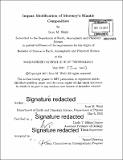Impact modification of Mercury's mantle composition
Author(s)
Wahl, Sean M
DownloadFull printable version (4.833Mb)
Other Contributors
Massachusetts Institute of Technology. Department of Earth, Atmospheric, and Planetary Sciences.
Advisor
Linda T. Elkins-Tanton.
Terms of use
Metadata
Show full item recordAbstract
Difficulties encountered in reproducing Mercury's compositional attributes through modeling of formational processes have bolstered support for the hypothesis that one or more giant impacts stripped away a significant proportion of proto-Mercury's silicate mantle. Previous investigations demonstrate sufficient removal of mantle material to account for the planets unusually high mean density, but do not consider the effects of multiple silicate and oxide phases. In this study, we extend the present theory by investigating the consequences of a more realistic chemical model on the evolution of the ejected material. We suggest that the majority of condensation within the expanding vapor plume can be modeled as an equilibrium process following homogeneous nucleation of refractory phases leading to larger particle sizes than previously estimated. We use a thermodynamic model focused on major element composition of ejected material to analyze the effect of differential condensation on the expansion and final state of ejecta. We also adapt pre-existing models for chemistry of condensation and impact shock compression to address additional problems associated with the process. For ejecta of sufficiently high specific entropy, our simplified chemical models indicate that energy released during condensation of MgO-rich phases buffers the temperature, delaying or preventing onset of FeO condensation. If sufficient spatial separation between condensates and vapor arises or if significant amounts of uncondensed FeO vapor remain uncondensed, reaccumulated ejecta would be enriched in MgO and refractory phases. This is compatible with an FeO depletion of Mercury's surface relative to other terrestrial bodies as some spectroscopic data suggests. The proposed process leads to a greater depletion in FeO and a lesser depletion in refractory, incompatible elements (Al2 O3, CaO, TiO2 ), than models assuming uniform removal of material from a differentiated proto-Mercury.
Description
Thesis: S.B., Massachusetts Institute of Technology, Department of Earth, Atmospheric, and Planetary Sciences, 2011. Cataloged from PDF version of thesis. Includes bibliographical references (pages 53-57).
Date issued
2011Department
Massachusetts Institute of Technology. Department of Earth, Atmospheric, and Planetary SciencesPublisher
Massachusetts Institute of Technology
Keywords
Earth, Atmospheric, and Planetary Sciences.